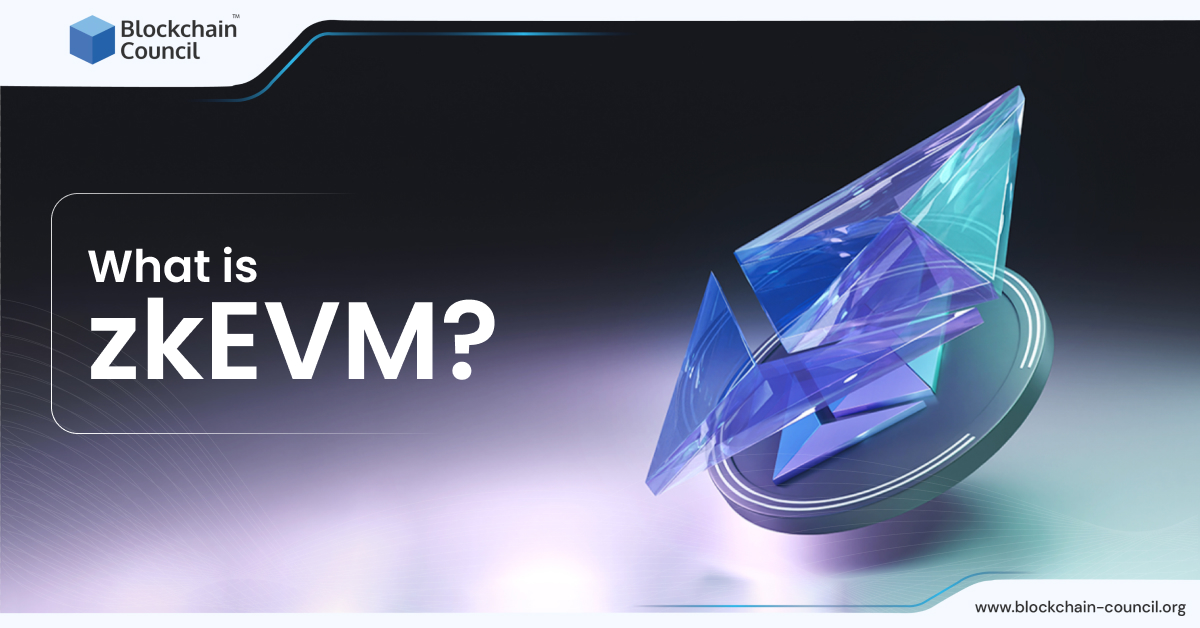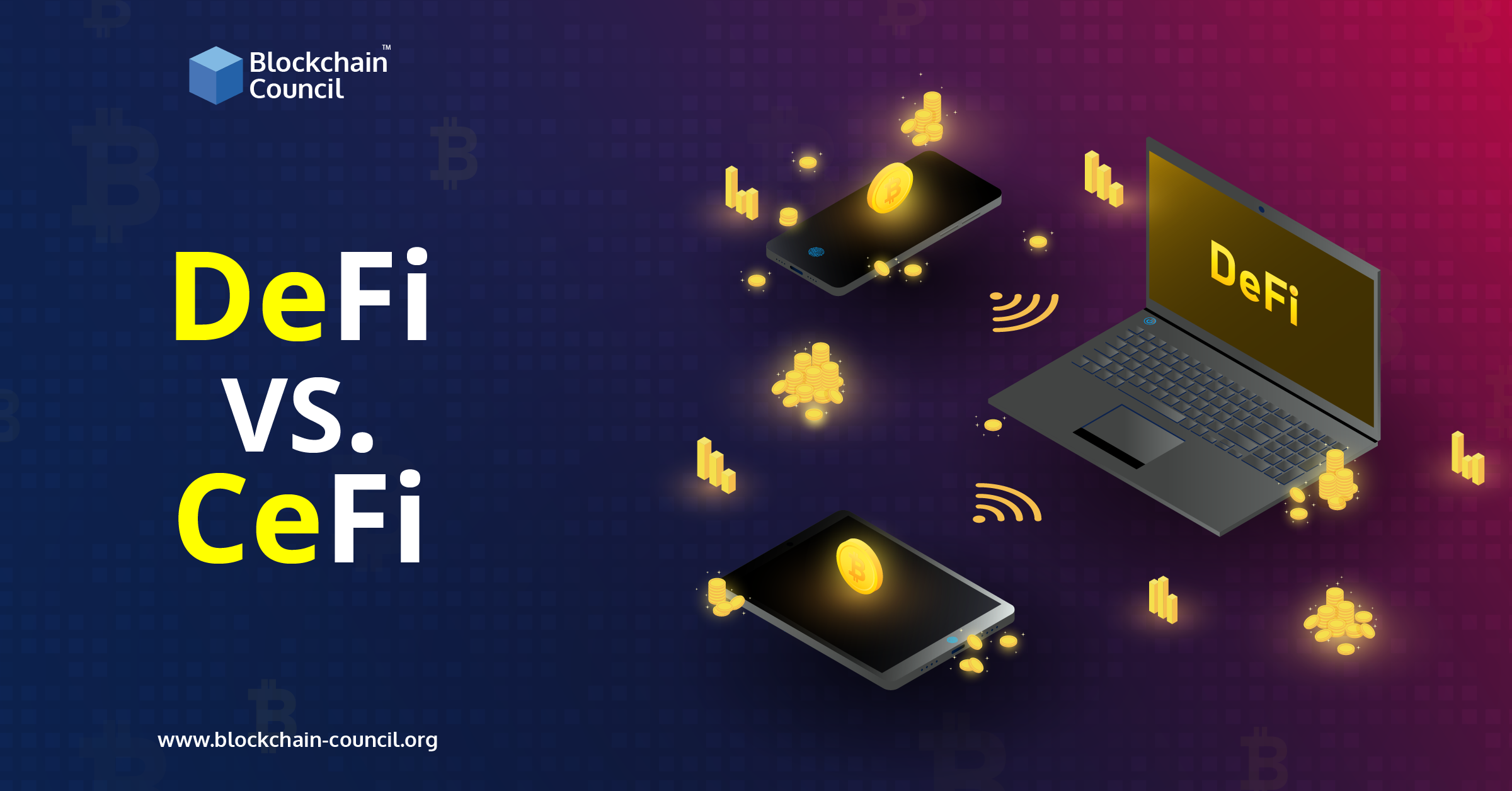
- Blockchain Council
- November 01, 2023
Summary
- In the era of digital transformation, zkEVM is gaining prominence as a technology combining the Ethereum Virtual Machine (EVM) with zero-knowledge proofs (ZKPs).
- Zero-knowledge proof (ZKP) is a cryptographic method to prove knowledge of specific information without revealing the information itself.
- Ethereum Virtual Machine (EVM) is the core of the Ethereum Blockchain, executing smart contracts.
- zkEVM, or zero-knowledge Ethereum Virtual Machine is a tool combining Ethereum’s smart contracts with zero-knowledge proofs for secure and private transaction execution.
- Zero-knowledge proofs were initially used for enhancing privacy in web3 applications.
- Verifiable computation, enabled by zero-knowledge proofs, enhances the security and scalability of public Blockchains.
- zkEVM makes Blockchain transactions faster and more secure by off-chain computation, zero-knowledge proof generation, and on-chain verification.
- Off-chain computation in zkEVM prepares the details of a transaction before it’s executed on the Blockchain.
- Zero-knowledge proofs validate bytecode, opcodes, input/output values, and computation sequence.
- zkEVM offers enhanced scalability, privacy, security, reduced transaction costs, and seamless interoperability for Blockchain applications.
Introduction
In the era of digital transformation, privacy, and security are paramount. As we tread this exciting yet complex path of decentralized applications and smart contracts, one term is making waves: zkEVM. Ever wondered how you could execute transactions on a Blockchain securely, swiftly, and without revealing critical information? Welcome to the combination of the Ethereum Virtual Machine (EVM) and zero-knowledge proofs (ZKP). But what is zkEVM and why is it so beneficial? Basically, it is an EVM that brings together Ethereum Virtual Machine and Zero-knowledge proof to make Blockchain transactions faster and more secure.
In this article, we’ll explain what zkEVM is and explore its profound impact on the future of Blockchain technology. So, let’s dive in all while keeping it light and relatable!
What is Zero-Knowledge Proof (ZKP)?
Zero-knowledge proof is a cryptographic method that allows one party (the prover) to demonstrate to another party (the verifier) that they know a specific piece of information or a secret, without revealing the actual information itself. In simpler words, it’s a way to prove that you have certain knowledge without disclosing what that knowledge is.
What is Ethereum Virtual Machine (EVM)?
The Ethereum Virtual Machine (EVM) is like the heart of the Ethereum Blockchain. It’s a decentralized computer that executes smart contracts, which are self-executing agreements with predefined rules.
What is zkEVM?
As stated earlier, zkEVM (zero-knowledge Ethereum Virtual Machine) is a technology that combines Ethereum’s smart contracts with a powerful cryptographic tool called zero-knowledge proofs (ZKPs). This combination ensures that smart contract transactions are not only executed correctly but also verified in a highly secure and private way. It empowers developers and users with an “Ethereum-like” experience, but what sets it apart are the zero-knowledge proofs, also known as “validity proofs,” which validate the correctness of execution.
Initially, zero-knowledge proofs were used for enhancing the privacy of web3 applications. Notable examples include ZCash for private payments, MACI for anonymous on-chain voting, and Aztec for private smart contracts. However, researchers soon realized another potent application: verifiable computation.
Verifiable computation allows a less powerful, yet untrusted, computer to outsource tasks to a more robust one and then verify the accuracy of the results. This is achieved through zero-knowledge proofs, and zkEVMs bring this concept to public Blockchains, significantly improving their security and scalability.
Imagine you want to do something on the Blockchain, like transferring digital assets. In a regular system, it might take time and resources to validate this. With zkEVM, the process becomes much faster and secure. Now how does zkEVM achieve this?
Let’s find out how zkEVM works!
How does zkEVM work?
Now that we know the answer to, “What is zkEVM?” Let’s understand how it works!
| Step | Description |
| Step 1: Off-chain Computation | – zkEVM processes the current state and transaction data
– Executes smart contract off-chain – Produces a final state |
| Step 2: Generating the Proof | – Creates a zero-knowledge proof (ZKP)
– Validates script execution – Verifies bytecode, opcodes, input/output values, and computation sequence |
| Step 3: On-chain Verification | – Submits proof and data to a verifier contract on the main Blockchain
– Verifier contract checks proof legitimacy – Updates the Blockchain state if verification succeeds |
Step 1: Off-chain Computation
Think of zkEVM as a backstage team preparing for a grand theatrical performance. Before anything hits the stage (the Blockchain), a lot happens behind the scenes. zkEVM takes the current state, much like the script, and the details of a transaction, which are the actors and their cues.
- Execution Environment: zkEVM has an execution environment where it runs the off-chain computation to execute a smart contract transaction. This environment processes all the details and produces a resultant final state, which is like the performance’s outcome.
Step 2: Generating the Proof
Once the off-chain computation is completed, zkEVM creates a special kind of proof, often referred to as a zero-knowledge proof (ZKP). Think of this proof as the equivalent of a backstage pass that allows you to access all areas of the theater and validates everything was done according to the script. The core of this proof is the proving circuit. It verifies several crucial aspects:
- Bytecode and Opcode: Bytecode represents the script (smart contract code) in a machine-readable format, while opcodes are like individual acting instructions within the script. The proving circuit checks if these are authentic and valid, ensuring that the script was executed correctly.
- Input and Output Values: The proving circuit scrutinizes whether the actors (the program) fetched the right information and value before the performance and whether the record of the performance’s results is accurate.
- Computation Sequence: It also ensures that the execution of instructions happened in the correct order, just like making sure actors deliver their lines in the right sequence.
Step 3: On-chain Verification
The proof, along with data about the initial and final states, is submitted to a verifier contract on the main Blockchain, often Ethereum. This contract acts as a vigilant audience, ensuring everything aligns with the script (the code). If everything checks out, the Blockchain updates itself based on this verified information.
- Verifier Contract: This contract plays a pivotal role in the process, as it performs the critical task of verifying the proof’s legitimacy. It’s like the audience members who ensure that the performance matches their expectations. Once it gives the green light, the Blockchain updates its state based on this verified data.
Now, let’s put this technical process into everyday terms.
Imagine zkEVM as an event organizer for an online concert ticket purchase. You, as a buyer, initiate a transaction to buy tickets (that’s your Blockchain transaction). The ticket seller (represented by zkEVM) processes your payment details and ensures that the tickets you want are available (off-chain computation).
After the off-chain preparation is complete, the ticket seller provides you with a special proof, which includes a receipt and a confirmation email (generating the proof). This proof is like your backstage pass, proving that your transaction was processed correctly.
Finally, this proof, along with your payment details, is checked by the event organizer (the verifier contract). They meticulously ensure that everything aligns with the script (the Blockchain’s rules). If everything checks out, the concert ticket sales record is updated, and you receive your tickets.
Also Read- Top 5 Blockchain Trends To Watch Out For In 2024
Benefits of zkEVM
We know what zkEVM is and how it works. Now, let’s explore what makes zkEVM so beneficial.
| Benefits of zkEVM | Description |
| Enhanced Scalability | Increases transaction speed to 2,000 TPS, solving Ethereum’s slow processing issue. |
| Privacy and Security | Keeps transactions private with Zero-Knowledge Proofs (ZKPs) while maintaining EVM compatibility for security. |
| Reduced Transaction Costs | Drastically reduces transaction fees by processing multiple transactions together. |
| Seamless Interoperability | Enables easy migration of existing smart contracts and dApps to zkEVM without code changes. |
Ethereum’s Scaling Issue
Ethereum, often touted as the world’s decentralized supercomputer, is plagued by an Achilles’ heel: scalability. It operates at a snail’s pace, capable of handling just around 30 transactions per second (TPS). This bottleneck results in high transaction fees and delays in confirming transactions, frustrating both developers and users. This is where zkEVM comes into play, aiming to transform Ethereum’s limitations into strengths.
The Power of zkEVM
zkEVM, or Zero-Knowledge Ethereum Virtual Machine, brings a robust solution to Ethereum’s scaling woes. It turbocharges transaction throughput by boosting it to over 2,000 TPS, offering a swift and efficient alternative to Ethereum’s sluggish base layer.
But zkEVM doesn’t stop at just scaling. It’s a multi-tool, combining scalability with privacy, security, and interoperability. This unique combination is a game-changer for the Ethereum ecosystem.
Enhanced Privacy and Security
Privacy is a top concern in the Blockchain world. zkEVM leverages Zero-Knowledge Proofs (ZKPs) to ensure that transactions remain confidential. These ZKPs allow the network to validate transactions without revealing their details, offering a significant boost in privacy compared to traditional Ethereum.
Moreover, zkEVM retains the EVM compatibility, ensuring that the security and privacy-preserving features of zk-Rollups are preserved. This means zkEVMs can work seamlessly with smart contracts and decentralized applications (dApps) used on Ethereum. They are also designed to function on EVM-compatible Blockchains like Avalanche, Solana, and Fantom, extending their utility beyond the Ethereum ecosystem.
Reduced Transaction Costs
One of the most significant advantages of zkEVMs is their ability to drastically lower transaction costs. At the time of writing, Ethereum transaction costs were approximately $0.90 per transaction in USD. zkEVMs can process hundreds or even thousands of transactions in a single batch off-chain. This means that the cost per transaction can be divided among all the transactions within a rollup, reducing the cost to less than $0.01 for simple transactions. In fact, a bundle of around 100 transactions could be executed for less than $0.10 worth of cryptocurrency.
Seamless Interoperability
zkEVMs bring a new level of interoperability. Existing smart contracts and dApps can effortlessly migrate to a zkEVM, harnessing the benefits of rollups without requiring any code modifications. The best part is that zkEVMs maintain a similar level of security as the native Ethereum Blockchain protocol since they are verified on Ethereum, just like other rollup solutions.
Also Read- How To Become A DApp Developer?
Types of zkEVM
| Type | Example |
| Type-1 zkEVMs | zkEVM Community Edition |
| Type-2 zkEVMs | Scroll, Polygon Hermez |
| Type-2.5 zkEVMs | N/A (EVM-Equivalent, Except for Gas Costs) |
| Type-3 zkEVMs | Polygon Hermez, Scroll |
| Type-4 zkEVMs | N/A (High-Level Language Equivalent) |
Type-1 zkEVMs: Fully Ethereum-Equivalent
Type-1 zkEVMs, like the zkEVM Community Edition, are unyielding in their commitment to Ethereum equivalence. They make no alterations to the existing Ethereum system, ensuring perfect compatibility with Ethereum-native applications. This means they can verify Ethereum blocks as they are today, making them an ideal choice for the long-term scalability of Ethereum. However, the problem is with prover time. Due to Ethereum’s non-ZK-friendly design, generating proofs for Ethereum blocks can take hours.
Type-2 zkEVMs: Fully EVM-Equivalent
Type-2 zkEVMs, exemplified by projects like Scroll and Polygon Hermez, strike a balance between compatibility and efficiency. They closely resemble Ethereum at the Virtual Machine level but introduce minor modifications to accelerate proof generation and development. While they offer faster prover times compared to Type-1, current implementations are still considered too slow for some demanding use cases.
Type-2.5 zkEVMs: EVM-Equivalent, Except for Gas Costs
To tackle the challenge of slow prover times, Type-2.5 zkEVMs opt for an unconventional approach. By significantly increasing the gas costs for specific operations, they can improve worst-case prover times. However, this comes at the cost of application compatibility, as it may break some existing applications and necessitate developer adjustments.
Type-3 zkEVMs: Almost EVM-Equivalent
Type-3 zkEVMs, represented by projects like Polygon Hermez and Scroll, balance compatibility and prover efficiency. They sacrifice some EVM features to make development and proof generation easier. While most Ethereum applications function smoothly, some may require rewriting due to changes in precompiles, VM memory, stack, and smart contract code handling.
Type-4 zkEVMs: High-Level Language Equivalent
Type-4 zkEVMs take a unique route by compiling high-level smart contract source code (e.g., Solidity or Vyper) into a language designed for optimal ZK-SNARK performance. The advantage here is lightning-fast prover times, reduced costs, and simplified decentralization. However, this approach may introduce incompatibilities with contracts relying on specific bytecode addresses and can disrupt debugging infrastructure that operates over EVM bytecode.
Conclusion
The digital landscape is shifting rapidly, and at the forefront of this change is zkEVM. Combining the power of Ethereum’s EVM with the security and privacy of zero-knowledge proofs, zkEVM is redefining what’s possible in the Blockchain space. From solving Ethereum’s scalability issues to drastically reducing transaction costs, zkEVM offers solutions to some of the most pressing challenges faced by the Blockchain community. As we move towards a decentralized future, technologies like zkEVM are not just desirable but essential. Embracing and understanding such innovations ensures that we’re not only participants in this digital revolution but also catalysts driving it forward.
FAQs
What is the use of zkEVM?
- zkEVM is used for secure and private Blockchain transactions.
- It enhances privacy in web3 applications and allows for verifiable computation.
- Improves Blockchain scalability and efficiency.
How does zkEVM work?
- Off-chain Computation processes data and executes smart contracts.
- Generating the Proof creates zero-knowledge proofs (ZKPs).
- On-chain Verification checks proof legitimacy and updates the Blockchain.
What is a zkVM?
- A zkVM combines zero-knowledge proofs with virtual machine technology for secure, private, and efficient Blockchain execution.
What are the advantages of zkEVM?
- Enhanced Scalability with faster transaction speeds.
- Privacy and Security with Zero-Knowledge Proofs (ZKPs).
- Reduced Transaction Costs.
- Seamless Interoperability for smart contracts and dApps.
What are the types of zkEVM?
- Type-1 zkEVMs: Fully Ethereum-equivalent.
- Type-2 zkEVMs: EVM-equivalent with minor modifications.
- Type-2.5 zkEVMs: EVM-equivalent with increased gas costs.
- Type-3 zkEVMs: Almost EVM-equivalent.
- Type-4 zkEVMs: Compiles high-level smart contract source code for ZK-SNARK performance.





































































 Guides
Guides News
News Blockchain
Blockchain Cryptocurrency
& Digital Assets
Cryptocurrency
& Digital Assets Web3
Web3 Metaverse & NFTs
Metaverse & NFTs
